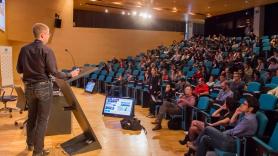1. Epigenetics: The dark genome and beyond
“Until recently, we had a dogmatic view that established a very simple relationship: one gene equals one protein,” explained Luciano Di Croce, ICREA professor, group leader at the Center for Genomic Regulation in Barcelona and scientific leader of this B·Debate. “That made research very easy, because we could focus on the 2% of the genome that is made up of genes and discard the other 98%. But we were wrong,” he said.
Although scientists had suspected this was a mistake for some time, a large international consortium turned this dogma on its head in 2012. The Encode project (Encyclopedia of DNA Elements) established that at least 80% of DNA has some biological function. Although it wasn’t clear what was meant by function, one thing was clear: the vast majority of the genome is active.
The majority of that activity has to do with DNA transcription. In general, the genome’s instructions are related to protein synthesis: the letters of DNA, when transcribed, act as a mold for RNA, which in turn acts as a mold (like Russian nesting dolls) for proteins, the building blocks of cells. This part, however, only makes up 2% of the book: genes. Nearly all the other DNA is transcribed into RNA, although it doesn’t synthesize proteins. This is what is known as non-coding RNA. And we now know that the majority of them allow for regular expression (transcription) of genes.
This is one of the pillars of epigenetics, defined as the sum of the inheritable changes that don’t depend directly on the DNA sequence, and which act basically by controlling how genes work, switching them on or off. But there are at least two other pillars, and these have to do with histones, the proteins that the genome wraps around, and DNA methylation, small marks on some of the letters.
The genome shouldn’t be considered a linear book; it is a 3-D pop-up book. To read its parts (or to encode them, which is sometimes as important as decoding them), the cell machinery has to be able to get to them, and that depends on how exposed it is. By modifying histones (adding or removing chemical marks), it becomes looser or tighter. Methylation of some of the C letters (cytosine) generally tightens the genome making it harder to read.
This is what allows a neuron to be a neuron and a hepatocyte, a hepatocyte, even though their genes are exactly the same.



